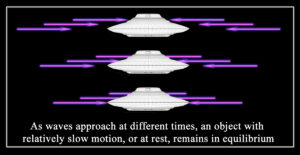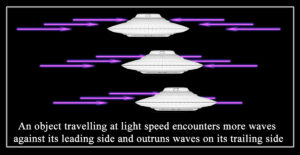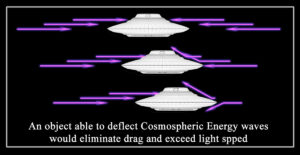Part VIII - Warp Drive
According to Einstein’s Theory of Relativity, nothing of mass can reach or exceed the speed of light. His reasoning, which was deduced mathematically and entirely without actual evidence, was that the faster matter travels, the more its mass increases. As its mass increases, more force is needed to accelerate the object to faster speeds.
According to that theory, as matter approaches the speed of light, its mass approaches infinity, which would require an infinitely strong force to accelerate the matter up to the speed of light. Since infinite forces can’t exist, the conclusion was that nothing could reach the speed of light, let alone exceed it.
Whether or not an object of matter can reach or exceed the speed of light has yet to be proven or disproven, but in any case, Einstein’s understanding was sabotaged by Newton’s false assumptions about gravity. Einstein needed to work out a fantastically complex, counter-intuitive model of the universe that is nearly impossible for many to understand and often impossible for experts to explain clearly.
The reason that objects of matter can’t reach or exceed the speed of light is actually quite simple, given this new understanding of Cosmospheric Energy and its resulting forces on objects of matter. The problem is the same as in any other method of locomotion we’ve devised: the problem is drag.
Airplanes and automobiles can only go so fast because as their speed increases, the more air needs to be displaced, requiring ever-increasing thrust to accelerate the craft to higher speeds. In a boat, water provides the same resistance. This resistance is known as drag – the force that opposes thrust caused by an object of mass moving through a medium.
When an object in space is relatively still or travelling with a low velocity (nowhere near the speed of light), the Cosmospheric Energy bombardment is more-or-less equal from all directions, as long as the object is not near the outskirts of the universe (see Part VII – Universal Expansion).
However, the faster an object moves, the greater the imbalance of Cosmospheric Energy waves impacting its surface. An object moving at high speed is approaching more Cosmospheric Energy waves ahead of it than waves behind it.
On its leading side, the object encounters more waves because it is catching up to waves that would have taken longer to impact if the object was slower or stationary. At the same time, it is outrunning waves on its trailing side that would have already impacted.
An object moving with substantial velocity approaches substantially more Cosmospheric Energy waves on its leading side. This produces drag on the object. To accelerate its velocity further, increased external force against its trailing side is needed to overcome the increased energy bombardment upon its leading side.
An object moving nearly at light speed would encounter tremendous amounts of Cosmospheric Energy upon its leading side, and almost none upon its trailing side. The increasing amount of force needed to accelerate faster is not due to the object’s increasing mass, but rather the increasing “headwind” drag of Cosmospheric Energy waves.
It may be possible, however, to devise a system that could deflect and/or reflect Cosmospheric Energy waves, preventing this energy from impacting a spacecraft on its leading side. Such a system could reduce the drag effect in similar fashion that automobiles, airplanes, and boats are designed with streamlined fuselages, and enable vessels to potentially exceed the speed of light.
The successful engineering of this system would be unquestionably the most triumphant achievement in all of human history.





